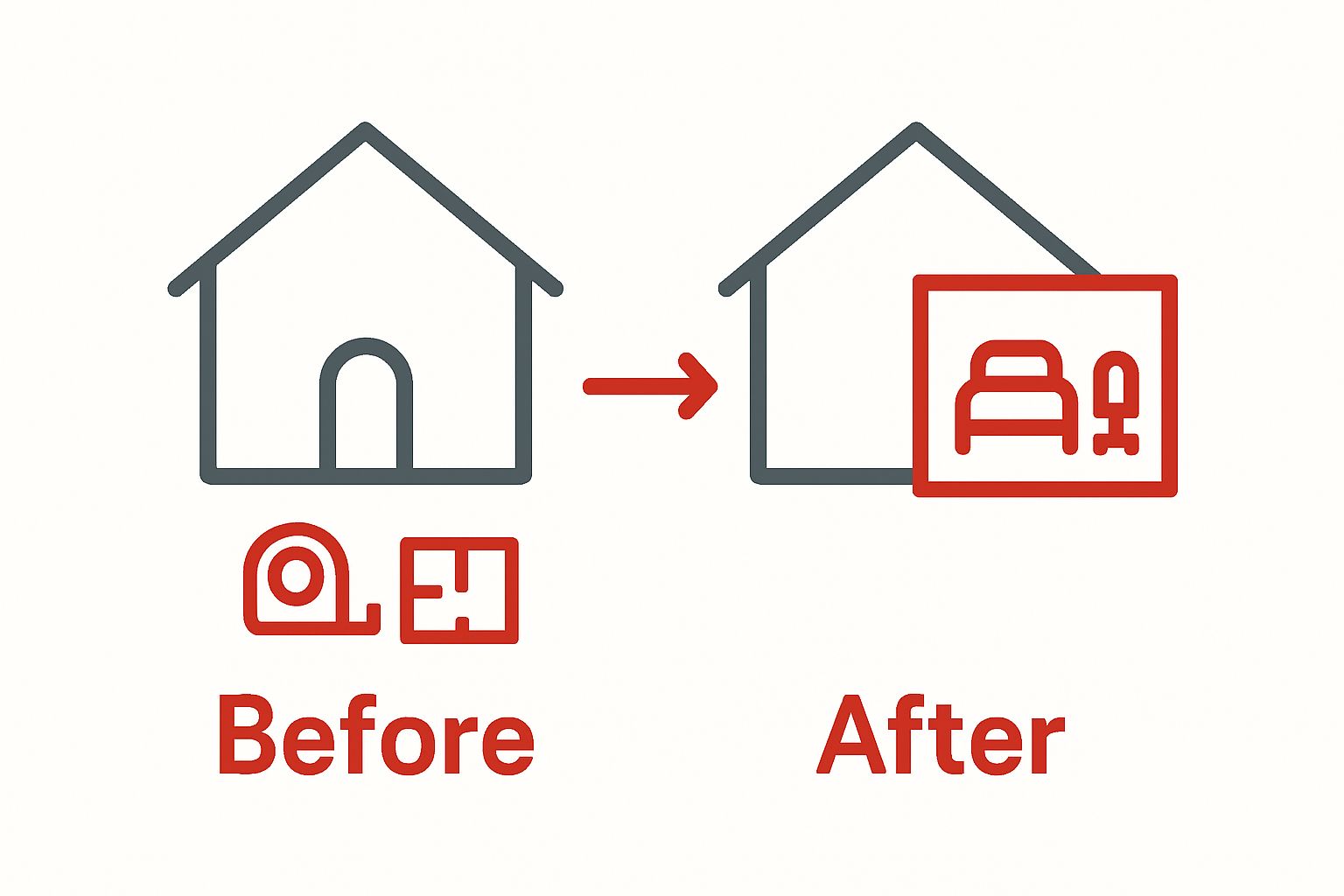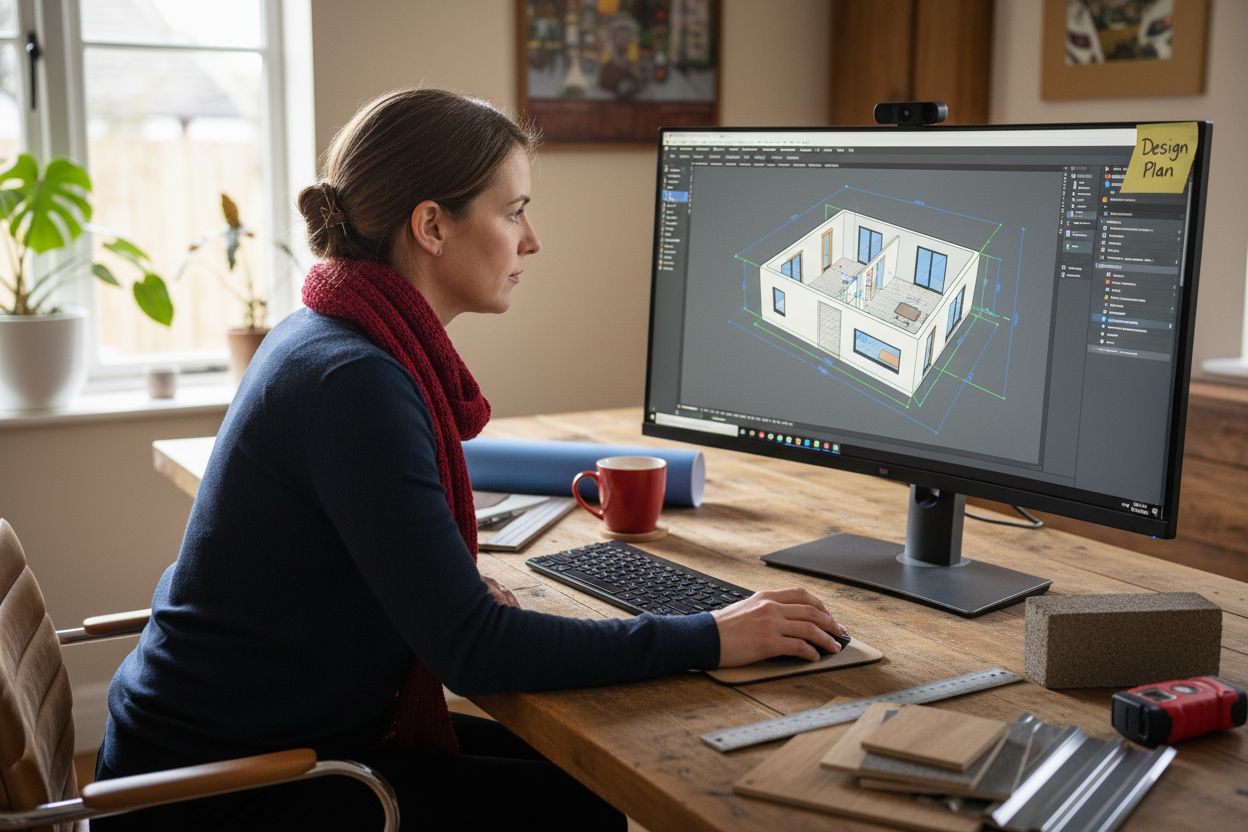Extending your house promises more space, better flow, and a boost in comfort. Yet nearly 25 percent of home extensions in the UK encounter costly planning or construction snags, leaving homeowners frustrated and over budget. Most guides focus on the build, but the real secret lies in what you do before anyone picks up a hammer.
Table of Contents
- Step 1: Assess Your Current Space Needs
- Step 2: Research Local Planning Regulations
- Step 3: Create A Detailed Design Plan
- Step 4: Obtain Necessary Permits And Approvals
- Step 5: Hire Qualified Contractors Or Specialists
- Step 6: Inspect Completion And Verify Quality
Quick Summary
| Key Point | Explanation |
|---|---|
| 1. Assess current space needs thoroughly | Conduct a room-by-room analysis to identify inefficiencies and measure dimensions accurately. |
| 2. Research local planning regulations | Understand specific guidelines and restrictions from your local council affecting your planned extension. |
| 3. Develop a detailed design plan | Create precise plans using professional software to visualize and refine your extension concepts. |
| 4. Prepare thorough application documentation | Compile all necessary architectural and structural documents to meet local authority requirements for permits. |
| 5. Hire qualified contractors with references | Seek recommendations and verify credentials of contractors to ensure quality and reliability for your project. |
Step 1: Assess your current space needs
Expanding your home starts with a critical foundation: understanding your current living space and future requirements. This initial assessment is more than a casual walkthrough it’s a strategic examination of how your home currently functions and where potential improvements can transform your living experience.
Begin by conducting a comprehensive room-by-room analysis. Walk through each space with a critical eye, noting areas of inefficiency, cramped layouts, or unused potential. Pay special attention to high-traffic zones like kitchens, living rooms, and bedrooms where space constraints become most apparent. Consider how your family uses each room and identify specific pain points. Are children sharing bedrooms? Is the kitchen too small for family meal preparation? Does your home office feel claustrophobic?
Measurement becomes your primary tool in this assessment. Take precise measurements of each room, documenting not just square meterage but also doorway widths, ceiling heights, and existing architectural features. Create a simple floor plan sketch that allows you to visualise potential modifications. This visual representation helps you understand spatial relationships and potential extension opportunities.
Family dynamics play a crucial role in space assessment. Read our detailed guide on maximising home space to understand how different household configurations impact extension planning. Consider both current needs and anticipated changes. A growing family might require additional bedrooms, while remote workers may need dedicated workspace. Your extension should not just solve immediate challenges but provide flexibility for future lifestyle shifts.
Storage requirements often reveal unexpected space constraints. Examine your current storage solutions critically. Are wardrobes overflowing? Do you struggle to find space for seasonal items? Effective extensions can dramatically improve storage capacity, transforming cluttered spaces into organised, functional areas. Look for opportunities to integrate smart storage solutions within your potential extension design.

Finally, document your findings comprehensively. Create a detailed report outlining room measurements, identified limitations, and potential improvement areas. This document will become an invaluable reference when consulting architects and builders, ensuring your extension truly meets your household’s unique requirements.
Step 2: Research local planning regulations
Navigating the complex landscape of planning regulations is crucial before embarking on your home extension project. Local authorities have specific guidelines that can significantly impact your design and construction process, making thorough research an essential preliminary step.
Start by contacting your local council’s planning department directly. These municipal offices hold the definitive information about extension permissions specific to your property and neighbourhood. Prepare a detailed set of initial questions focusing on permitted development rights, potential restrictions, and specific requirements for your property type. Different areas have unique considerations based on conservation zones, listed building status, and local architectural characteristics.
Learn more about planning permission requirements to understand the nuanced regulations that might apply to your specific situation. Each property carries its own set of potential constraints. Terraced houses, semi-detached properties, and detached homes have varying rules regarding extension size, height, and positioning. Pay particular attention to boundary restrictions, which often dictate how close you can build to neighbouring properties.
Documenting your research becomes crucial during this phase.
Create a comprehensive file containing all communications with the planning department, including dates of conversations, names of officials consulted, and specific guidance received. Detailed documentation protects you from potential future misunderstandings. Request written confirmation of verbal advice whenever possible, as this provides a formal record of the regulatory landscape surrounding your proposed extension.
Be prepared to invest time in understanding permitted development rights. Some extensions can proceed without full planning permission, but these come with strict limitations. Typically, these rights depend on factors like total ground coverage, maximum height, and proximity to property boundaries. Your extension must not exceed specific dimensional constraints, and the materials used must complement the existing property’s aesthetic.
Consider engaging a professional planning consultant or architect who understands local regulatory environments. Their expertise can help you navigate complex planning landscapes, anticipate potential challenges, and prepare documentation that aligns with local council expectations. While this represents an additional upfront cost, their guidance can save significant time and prevent costly redesigns or legal complications later in the process.
Step 3: Create a detailed design plan
Transforming your extension vision into a precise, actionable design requires meticulous planning and strategic thinking. This crucial stage bridges the gap between conceptual imagination and practical implementation, demanding both creativity and technical precision.
Begin by translating your space assessment into preliminary sketches. Professional-grade digital design tools can significantly enhance your planning process, allowing you to experiment with different layouts and configurations before committing to physical drawings. Consider using software like SketchUp or AutoCAD, which provide realistic 3D modelling capabilities that help visualise spatial relationships and potential design challenges.
Discover our comprehensive guide on kitchen extension design to understand how specific room functionalities can influence overall extension planning. Your design must harmonise with the existing architectural language of your home, ensuring the new space feels like a natural extension rather than an awkward addition. Consider factors like natural light penetration, flow between existing and new spaces, and how the extension will integrate with current structural elements.
Measurement becomes paramount during this phase. Precision is non-negotiable when creating design plans. Use laser measuring tools for absolute accuracy, documenting exact dimensions of existing spaces, proposed extension areas, window placements, and potential structural modifications. Create scaled drawings that account for every centimetre, understanding that even minor miscalculations can result in significant implementation challenges.
Engaging a professional architect or architectural technician can elevate your design from good to exceptional. These experts bring technical expertise that transforms conceptual ideas into buildable, regulation-compliant designs. They understand complex structural requirements, can identify potential engineering challenges, and provide insights into material selections that balance aesthetics, functionality, and budget constraints.
Consider developing multiple design iterations. Your first concept might not be the optimal solution, so create 2-3 variant designs that address your space needs from different perspectives. Each iteration should explore alternative approaches to room layout, material usage, and structural integration. This exploratory process helps identify the most effective design solution, revealing potential improvements that might not be immediately apparent in the initial concept.
Finally, compile a comprehensive design documentation package. This should include detailed floor plans, elevation drawings, material specifications, and a clear narrative explaining design rationales. A well-documented design plan communicates your vision effectively to contractors, planners, and potential builders, reducing misunderstandings and streamlining the subsequent construction phases.

Step 4: Obtain necessary permits and approvals
Navigating the bureaucratic landscape of permits and approvals represents a critical checkpoint in your home extension journey. This stage transforms your carefully crafted design from a conceptual plan into a legally sanctioned construction project, requiring methodical attention and strategic documentation.
Preparation becomes your most valuable tool when approaching the permitting process. Compile a comprehensive application package that includes detailed architectural drawings, precise site plans, structural calculations, and a comprehensive description of proposed work. Local authorities require exhaustive documentation that demonstrates your extension meets all regulatory standards. This means creating multiple copies of your design plans, ensuring each document is crisp, clear, and professionally presented.
Explore our guide on understanding the house extension approval process to gain deeper insights into the nuanced requirements of permit applications. Building regulations approval differs significantly from planning permission. While planning permission addresses visual and spatial considerations, building regulations focus on structural integrity, safety standards, and energy efficiency. Your submission must prove that the proposed extension meets stringent technical requirements covering aspects like thermal performance, structural stability, and fire safety.
Engaging professional support can dramatically streamline the approval process. Consider hiring a chartered architectural technician or planning consultant who understands local authority requirements. These professionals can anticipate potential queries, preemptively address potential concerns, and navigate the complex administrative landscape. Their expertise often proves invaluable in preparing documentation that speaks the technical language of regulatory bodies.
Timeline management becomes crucial during this phase. Permit approval processes can vary dramatically between different local authorities, typically ranging from 8 to 12 weeks for standard applications. Factor this waiting period into your overall project schedule, understanding that rushing or providing incomplete documentation can result in significant delays. Maintain open communication channels with the local planning department, promptly responding to any requests for additional information.
Document tracking represents another critical aspect of the permit acquisition process. Create a meticulous record of all submissions, including dates, reference numbers, and copies of all correspondence. Digital and physical backups are essential. Develop a systematic approach to filing, ensuring you can quickly reference any document if questions arise during the approval process. This level of organisation demonstrates professionalism and can potentially expedite your application review.
Step 5: Hire qualified contractors or specialists
Selecting the right team of contractors transforms your extension project from a conceptual design into a tangible reality. This critical stage demands a strategic approach that balances technical expertise, professional reputation, and interpersonal compatibility.
Begin by developing a comprehensive contractor selection strategy. Professional recommendations form the cornerstone of your search, so leverage networks including local architectural associations, trusted friends, and professional referral platforms. Personal recommendations carry significant weight, offering insights into a contractor’s reliability, workmanship quality, and ability to manage complex extension projects.
Learn more about understanding the house extension approval process to comprehend the technical expertise required from your selected specialists. Your ideal contractor should demonstrate a nuanced understanding of local building regulations, planning permissions, and structural complexities specific to home extensions.
Compile a rigorous interview process that goes beyond surface-level discussions. Request detailed portfolios showcasing previous extension projects similar to yours, paying close attention to architectural styles, complexity levels, and finished aesthetic quality. Verification becomes paramount during this phase. Examine physical evidence of previous work, request client testimonials, and investigate professional credentials such as membership in recognised trade associations.
Financial transparency represents another crucial evaluation criterion. Request comprehensive, itemised quotes that break down anticipated costs, including materials, labour, potential contingencies, and projected timelines. A professional contractor will provide a transparent, detailed proposal that demonstrates clear understanding of your project’s specific requirements. Be wary of quotes that seem unusually low or vague, as these often indicate potential hidden costs or substandard workmanship.
Technical competence must be balanced with communication skills. Your chosen team should demonstrate the ability to explain complex technical processes clearly, respond promptly to queries, and maintain open dialogue throughout the project. Schedule face-to-face consultations that allow you to assess not just their technical capabilities, but also their approach to project management and client communication.
Finalise your selection by developing a comprehensive written contract that explicitly outlines project scope, payment schedules, expected completion dates, and mechanisms for addressing potential variations or unexpected challenges. A well-structured contract protects both parties, providing clear expectations and legal framework for your extension project. This document should include detailed specifications from your original design plans, ensuring absolute clarity about project parameters.
Step 6: Inspect completion and verify quality
The final stage of your home extension journey demands meticulous attention to detail, transforming your vision from construction project to a fully realised living space. This critical inspection phase ensures every aspect of the extension meets your original design specifications, regulatory requirements, and quality expectations.
Systematic documentation becomes your primary investigative tool during the completion inspection. Bring your original design plans, permit documents, and contractual agreements to create a comprehensive verification checklist. Methodically compare each completed element against the original specifications, examining structural integrity, aesthetic alignment, and functional performance. Pay particular attention to areas like structural connections, thermal insulation, moisture barriers, and architectural transitions between existing and new spaces.
Explore our comprehensive guide on understanding house extension approval processes to comprehend the technical standards your extension must meet. Engage a professional building inspector or chartered surveyor to conduct an independent assessment. These experts bring an objective, technically trained perspective that can identify subtle issues potentially overlooked during construction.
Technical performance assessment goes beyond visual inspection. Test all integrated systems thoroughly, including electrical circuits, plumbing connections, heating integration, and ventilation mechanisms. Functional testing reveals potential implementation gaps that might not be immediately apparent. Run comprehensive checks on electrical outlets, light switches, heating controls, and any integrated smart home technologies. Verify that each system operates smoothly, efficiently, and complies with current building regulations.
Material quality and finishing represent another crucial inspection area. Examine surface finishes, paintwork, tiling, and structural junctions with a critical eye. Look for smooth transitions, precise alignments, and consistent quality across different areas of the extension. Minor imperfections can significantly impact the overall aesthetic and long-term durability of your new space.
Document every observation meticulously during the inspection process. Create a detailed report highlighting both achievements and areas requiring potential remedial work. This documentation serves multiple purposes: it provides a clear record for potential future maintenance, offers leverage for addressing any outstanding issues with contractors, and creates a comprehensive historical record of your extension project.
Finally, request all completion certificates, including building regulation approval documents and any warranty information. These official documents validate the legal and technical compliance of your extension, providing crucial protection and potential value enhancement for your property. Secure digital and physical copies, understanding that these certificates become important documentation for future property transactions or modifications.
Below is a checklist table to help you verify the quality and completeness of your home extension during the final inspection stage.
| Inspection Area | What to Check | Method of Verification | Required Documentation |
|---|---|---|---|
| Structural Integrity | Connections, stability, and safety | Visual and physical inspection | Building regulation consultancy report |
| Aesthetic Finishes | Paintwork, tiling, and surface joinery quality | Visual examination | Contractor handover checklist |
| Functional Systems | Electrical, plumbing, heating, ventilation | Operational testing | Certificates for installed systems |
| Storage and Layout | Integration and accessibility of storage solutions | Practical usability assessment | Floor plan and design comparison |
| Approval Compliance | Adherence to planning and building approvals | Document review | Approval letters, certificates |
| Defects or Snags | Minor imperfections and incomplete works | Detailed walkthrough and checklist | Defects report for contractor action |
| Completion Certificates | Receipt of all completion and warranty documents | Document collection | Official certificates and warranties |
Unlock a Seamless Home Extension Journey with Local Experts
Struggling to navigate the complex steps of expanding your home? If you feel overwhelmed assessing your space, interpreting planning regulations, or managing building approvals, you are not alone. Many homeowners face the same challenges when visualising and executing their ideal extension. At Reltic Extend, we specialise in removing those uncertainties by offering end-to-end support—from initial space assessments and design plans right through to clear project management. Our stage-by-stage approach ensures your expectations and goals set out in your step-by-step extension guide are achieved without costly mistakes or delays.
Your dream space deserves careful planning and peace of mind. We handle all permissions, apply over 20 years of experience, and guarantee our work, ensuring your extension is both beautiful and compliant. Now is the perfect time to take advantage of our transparent pricing, expert guidance, and inspiration for every type of extension. Feel ready to start? Contact us today for a free consultation tailored to your unique home and family needs.
Frequently Asked Questions
How do I assess my current space needs before starting a home extension?
Start by conducting a thorough analysis of each room in your home. Document measurements, layout inefficiencies, and areas that need improvement to understand what space is required for your future lifestyle.
What are the key local planning regulations I need to consider before an extension?
Research your local council’s guidelines regarding planning permissions and restrictions specific to your property type. Make a checklist of factors like boundary restrictions and permitted development rights before proceeding with your design.
How can I create a detailed design plan for my home extension?
Begin by translating your space requirements into sketches and utilise professional design software to visualise different configurations. Ensure that your design aligns with the architectural style of your home and includes precise measurements to prevent issues during construction.
What documentation do I need to obtain the necessary permits for my extension?
Compile a comprehensive application package that includes architectural drawings, site plans, and a detailed project description. Ensure all documents meet local regulatory standards to facilitate a smooth permitting process.
How do I select qualified contractors for my home extension project?
Develop a selection strategy that includes getting professional recommendations and reviewing candidates’ portfolios of similar projects. Interview several contractors to assess their technical expertise and communication skills before making your final choice.
What should I inspect during the final completion of my home extension?
Conduct a thorough inspection using a checklist to compare the completed work against your original plans. Focus on structural integrity and finishing quality, and document any discrepancies or areas that require rectification.
Recommended
- Lifestyle & Home Ideas for Modern Living | Reltic Extend
- 7 Innovative Living Room Extension Ideas for Your Home – Reltic Extend
- Extension Inspiration & Ideas for Your Home | Reltic Extend
- Types of Home Extensions & Ideas | Reltic Extend
- 8 Essential Outdoor Living Space Ideas for Homeowners – Landscaping in Charleston & Mt Pleasant, SC | Landscaping
- Why Your Home Reno Project Needs an Interior Designer ASAP | RumahHQ – Kontraktor Bina & Renovate Rumah





